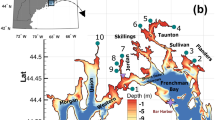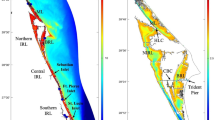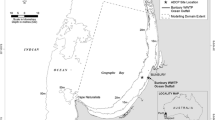Abstract
Numerical simulations were carried out to determine the residence (or flushing) time of water in Vidy Bay (north shore of Lake Geneva) for different meteorological conditions. A hydrodynamic model (Delft3D-FLOW) was applied to simulate the flow field in the embayment during 2010 and January 2011. Using these results, particle tracking was applied to estimate transport of wastewater effluent discharged into the embayment. The model predictions compared well with published field measurements of dissolved species (as given by electrical conductivity profiles) within the wastewater. The pelagic boundary of the embayment was defined by the largest within-bay gyre. Based on this definition, particle tracking was used to quantify the residence time under dominant wind conditions. Similarly, particle tracking was used to determine the travel time (i.e., time to exit the embayment) for each of Vidy Bay’s three inflows (stream, stormwater and wastewater effluent). Although the wind field over the lake is variable, current patterns in the embayment can be simulated using the hydrodynamic model forced by a spatially uniform wind field. For a given wind speed, the main factor influencing residence and travel times is the wind angle. The presence of gyres leads to high mean residence times with large variability. As the wind direction becomes more aligned with the shoreline (i.e., with increasing westerly or easterly components), longshore currents dominate. These disrupt gyre formation and markedly reduce the mean and variability of embayment residence time. The numerical model was utilized to assess the potential for plume movement (in plan) from above the wastewater effluent outfall towards one of Lausanne’s drinking water intakes. In the most direct pathway, westward longshore currents can move water from the embayment to the water column above the intake location.






Similar content being viewed by others
References
Appelo CAJ, Postma D (2005) Geochemistry, groundwater and pollution. Taylor and Francis, Amsterdam
Bohle-Carbonell M (1986) Currents in Lake Geneva. Limnol Oceanogr 31:1255–1266. doi:10.4319/lo.1986.31.6.1255
Bonvin F, Rutler R, Chèvre N, Halder J, Kohn T (2011) Spatial and temporal presence of a wastewater-derived micropollutant plume in Lake Geneva. Environ Sci Technol 45:4702–4709. doi:10.1021/es2003588
Bonvin F, Razmi AM, Barry DA, Kohn T (2013) A coupled hydrodynamic-photolysis model to simulate the fate of micropollutants in Vidy Bay. Environ Sci Technol 47:9207–9216. doi:10.1021/es401294c
Brookes JD, Antenucci J, Hipsey M, Burch MD, Ashbolt NJ, Ferguson C (2004) Fate and transport of pathogens in lakes and reservoirs. Environ Int 5:741–759. doi:10.1016/j.envint.2003.11.006
Buffoni G, Falco P, Griffa A, Zambianchi E (1997) Dispersion processes and residence times in a semi-enclosed basin with recirculating gyres: an application to the Tyrrhenian Sea. J Geophys Res 102:18699–18713. doi:10.1029/96JC03862
Choi KW, Lee JHW (2004) Numerical determination of flushing time for stratified water bodies. J Mar Syst 50:263–281. doi:10.1016/j.jmarsys.2004.04.005
Cipel. http://www.cipel.org (Accessed 10 Sep 2013)
COSMO. http://www.cosmo-modelorg/content/model/documentation/core/default.htm (Accessed 10 Sep 2013)
Daughton CG, Ternes TA (1999) Pharmaceuticals and personal care products in the environment: agents of subtle change? Environ Health Perspect 107:907–938. doi:10.1007/b11992
Delf3D-PART, User Manual 2009, Version: 2.13, Revision: 6359. http://www.deltaressystems.com/hydro/product/621497/delft3d-suite (Accessed 10 Sep 2013)
Delft3D-FLOW, User Manual 2011, Version: 3.15, Revision: 17474. http://www.deltaressystems.com/hydro/product/621497/delft3d-suite (Accessed 10 Sep 2013)
Elwell FC (2004) Flushing of embayments. Unpublished PhD thesis, Queens’ College, Cambridge. http://www.damtp.cam.ac.uk/lab/people/fcg21/thesis.pdf
Falconer RA, George D, Hall P (1991) Three-dimensional numerical modeling of wind-driven circulation in a shallow homogenous lake. J Hydrol 124:59–79. doi:10.1016/j.advwatres.2004.08.004
Gascon Diez E, Bravo AG, Porta N, Masson M, Graham ND, Stoll S, Akhtman Y, Amouroux D, Loizeau JL (2013) Mercury content and speciation related to sediment surface patterns in contaminated Vidy Bay, Lake Geneva, Switzerland. Aquat Sci (this issue)
Ge ZF, Nevers MB, Schwab DJ, Whitman RL (2010) Coastal loading and transport of Escherichia coli at an embayed beach in Lake Michigan. Environ Sci Technol 44:6731–6737. doi:10.1021/es100797r
George DG, Edwards RW (1976) The effect of wind on the distribution of chlorophyll and crustacean plankton in a shallow eutrophic reservoir. J Appl Ecol 13:667–690. http://www.jstor.org/stable/2402246
Gill AE (1982) Atmosphere-ocean dynamics. Int Geophys Series, vol 30. Academic Press. San Diego
Haldimann S (2010) Modélisation des rejets lausannois dans le Léman. Schweiz Verein des Gas- und Wasserfaches. 3:209–220
Harris EL, Falconer RA, Lin B (2004) Modeling hydroenvironmental and health risk assessment parameters along the South Wales Coast. J Environ Manage 73:61–70. doi:10.1038/leu.2012.326
Hipsey MR, Antenucci JP, Brookes JD (2008) A generic, process-based model of microbial pollution in aquatic systems. Water Resour Res 44:W07408. doi:10.1029/2007WR006395
Hoerger CC, Akhtman Y, Martelletti L, Rutler R, Bonvin F, Grange A, Arey JS, Kohn T (2013) Spatial extent and ecotoxicological risk assessment of a micropollutant-contaminated wastewater mass in Lake Geneva. Aquat Sci (this issue)
Jackson TR, Haggerty R, Apte SV, Coleman A, Drost KJ (2012) Defining and measuring the mean residence time of lateral surface transient storage zones in small streams. Water Resour Res 48:W10501. doi:10.1029/2012WR012096
Ji Z (2008) Hydrodynamics and water quality: modeling rivers, lakes, and estuaries. Wiley, New Jersey
Kristal D, Anderson MA, Yates MV (2005) Distribution of indicator bacteria in Canyon Lake, California. Water Res 39:1277–1288. doi:10.1016/j.watres.2005.01.011
Lemmin U, D’Adamo N (1996) Summertime winds and direct cyclonic circulation: observations from Lake Geneva. Ann Geophys 14:1207–1220. doi:10.1007/s00585-996-1207-z
Lesser GR, Roelvink JA, Van Kester JATM, Stelling GS (2004) Development and validation of a three-dimensional morphological model. Coast Eng 51:883–915. doi:10.1016/j.coastaleng.2004.07.014
Margot J, Kienle C, Magnet A, Weil M, Rossi L, de Alencastro LF, Abegglen C, Thonney D, Chèvre N, Schärer M, Barry DA (2013) Treatment of micropollutants in municipal wastewater: ozone or powdered activated carbon? Sci Total Environ 7:480–498. doi:10.1016/j.scitotenv.2013.05.034
Masson M, Tercier-Waeber ML (2013) Trace metal speciation at the sediment-water interface of the Vidy Bay: influence of contrasting sediment characteristics. Aquat Sci (this issue)
McCormick MJ, Schwab DJ (2008) Observations of currents in Saginaw Bay, Lake Huron. Aquat Ecosyst Health Manage 11:182–189. doi:10.1080/14634980802092997
MeteoSwisse. http://www.meteoswiss.admin.ch (Accessed 10 Sep 2013)
Okubo A (1973) Effect of shoreline irregularities on streamwise dispersion in estuaries and other embayments. Netherlands J Sea Res 6:213–224
Oulton RL, Kohn T, Cwiertny DM (2010) Pharmaceuticals and personal care products in effluent matrices: a survey of transformation and removal during wastewater treatment and implications for wastewater management. J Environ Monit 12:1956–1978. doi:10.1039/c0em00068j
Peeters F, Wüest A, Piepke G, Imbeden DM (1996) Horizontal mixing in lakes. J Geophys Res 101:18361–18375. doi:10.1029/96JC01145
Poté J, Goldscheider N, Haller L, Zopfi J, Khajehnouri F, Wildi W (2009) Origin and spatial-temporal distribution of faecal bacteria in a bay of Lake Geneva, Switzerland. Environ Monit Assess 154:337–348. doi:10.1007/s10661-008-0401-8
Razmi AM, Barry DA, Bakhtyar R, Le Dantec N, Dastgheib A, Lemmin U, Wüest A (2013) Current variability in a wide and open lacustrine embayment in Lake Geneva (Switzerland). J Great Lakes Res 39:455–465. doi:10.1016/j.jglr.2013.06.011
Rueda FJ, Cowen EA (2005) Exchange between a freshwater embayment and a large lake through a long, shallow channel. Limnol Oceanogr 50:169–183. doi:10.4319/lo.2005.50.1.0169
Sauvain L, Bueche M, Junier T, Masson M, Wunderlin T, Kohler-Milleret R, Gascon Diez E, Loizeau JL, Tercier-Waeber ML, Junier P (2013) Bacterial communities in trace metal contaminated lake sediments are dominated by endospore-forming bacteria. Aquat Sci (this issue)
Scavia D, Bennett JR (1980) Spring transition period in Lake Ontario—a numerical study of the causes of the large biological and chemical gradients. Can J Fish Aquat Sci 37:823–833. doi:10.1139/f80-111
Schladow SG, Hamilton DP (1997) Prediction of water quality in lakes and reservoirs: part II—model calibration, sensitivity analysis and application. Ecol Model 96:111–123. doi:10.1016/S0304-3800(96)00063-4
Singell RP, Beardsley RC, Graber HC, Capotondi A (1990) Effect of wave-current interaction on wind-driven circulation in narrow, shallow embayments. J Geophys Res 95:9671–9678. doi:10.1029/JC095iC06p09671
Soulsby RL (1997) Dynamics of marine sands. Thomas Telford, HR Wallingford, London
Swiss coordinates. http://www.swisstopo.admin.ch (Accessed 10 Sep 2013)
Wüest A, Lorke A (2003) Small-scale hydrodynamics in lakes. Annu Rev Fluid Mech 35:373–412. doi:10.1146/annurev.fluid.35.101101.161220
Wüest A, Anselmetti FS, Arey JS, Ibelings BW, Loizeau JL, Vennemann T, Lemmin U (2013) Into the abyss of Lake Geneva—interdisciplinary field investigations using the MIR submersibles. Aquat Sci (this issue)
Wunderlin T, Corella JP, Junier T, Bueche M, Loizeau JL, Girardclos S, Junier P (2013) Endospore-forming bacteria as new proxies to assess impact of eutrophication in Lake Geneva (Switzerland-France). Aquat Sci (this issue)
Acknowledgments
This publication is part of the international, interdisciplinary research project ELEMO (http://www.elemo.ch) to investigate the deep-waters of Lake Geneva using two Russian MIR submarines. Funding for this study was provided by the Fondation pour l’Etude des Eaux du Léman (FEEL) and the Swiss National Foundation (PDFMP2-123034/1). We thank Jean-Denis Bourquin for providing administrative support. The authors thank the three anonymous reviewers and the editor for their useful comments.
Author information
Authors and Affiliations
Corresponding author
Additional information
This article is part of the special issue “éLEMO – investigations using MIR submersibles in Lake Geneva”.
Electronic supplementary material
Below is the link to the electronic supplementary material.
Rights and permissions
About this article
Cite this article
Razmi, A.M., Barry, D.A., Lemmin, U. et al. Direct effects of dominant winds on residence and travel times in the wide and open lacustrine embayment: Vidy Bay (Lake Geneva, Switzerland). Aquat Sci 76 (Suppl 1), 59–71 (2014). https://doi.org/10.1007/s00027-013-0321-8
Received:
Accepted:
Published:
Issue Date:
DOI: https://doi.org/10.1007/s00027-013-0321-8




